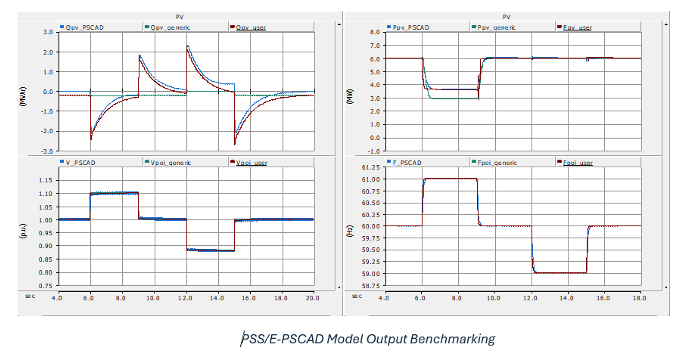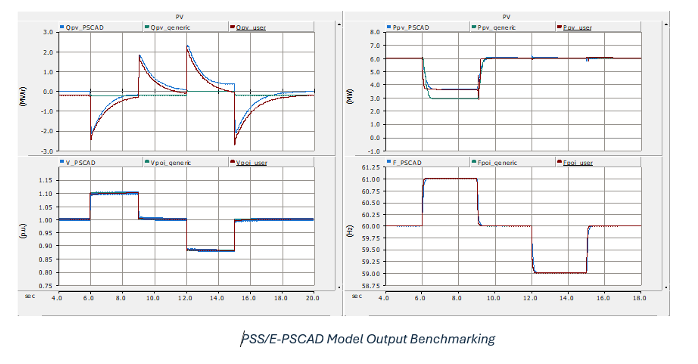 April 06, 2025 - BY Admin
April 06, 2025 - BY Admin
Electromagnetic transient (EMT) studies have evolved significantly, especially with the rise of inverter-based resources (IBR) such as solar PV, battery storage, and wind turbines. Traditional phasor-based simulation tools often fail to accurately capture the dynamic behavior of IBRs, making EMT programs like PSCAD essential in modern grid planning and interconnection studies.
Why EMT Studies Matter for IBR
 Unlike synchronous machines, IBRs rely on complex computer-based control systems, often proprietary and black-boxed. These controls can react instantaneously to grid disturbances, requiring precise modeling to predict behavior during faults or system changes. EMT studies help evaluate impacts like voltage ride-through, synchronization loss, and interactions within the grid, which are critical for maintaining stability.
Unlike synchronous machines, IBRs rely on complex computer-based control systems, often proprietary and black-boxed. These controls can react instantaneously to grid disturbances, requiring precise modeling to predict behavior during faults or system changes. EMT studies help evaluate impacts like voltage ride-through, synchronization loss, and interactions within the grid, which are critical for maintaining stability.
Practical Applications for EMT Studies:
1. Temporary Overvoltage (TOV): Simulates the response of solar PV inverters to ground faults, ensuring voltage stability and equipment protection.
2. Loss of Synchronization: Tests the PLL's ability to maintain synchronization under grid disturbances, helping to prevent control instability.
3. Unbalanced Fault Analysis: Analyzes how inverters inject negative-sequence currents during asymmetrical faults, maintaining grid support.
4. Benchmarking IBR Models: Compares high-fidelity EMT models with positive-sequence dynamic models to ensure consistent performance in planning studies.
5. Grid Forming BESS Tests: Evaluates the ability of battery energy storage systems to stabilize frequency and voltage after losing conventional generation.
6. Low Short-Circuit Strength: High-IBR penetration can lower fault levels, affecting protection schemes and voltage stability. EMT studies help assess potential voltage dips and stability risks.
7. Ride-Through Performance: IBRs must withstand grid disturbances without tripping. EMT simulations test their voltage and frequency ride-through capabilities, critical for compliance.
8. Sub-Synchronous Control Interaction: Fast-reacting inverter controllers can interact with grid elements, potentially causing oscillations. EMT studies help predict and mitigate such interactions.
9. Load rejection Overvoltage: A sudden loss of grid connection can isolate IBRs, leading to temporary overvoltage. EMT studies assess the risk and ensure protective measures are adequate.
Some typical list of metrics required by the utilities/ISOs for IBR model submission is shown in the table below:
Ensuring Model Accuracy and Reliability
To enhance the reliability of EMT simulations, it is essential to use validated models that accurately reflect real equipment behavior. Utilities and ISOs now establish standards for model quality and verification, including time-step requirements, scalability, initialization speed, and documented test results.
Model Requirements | Model Quality Assurance | Model Verification Tests |
· 10-20 us time step · Models shall be scalable and dispatchable · Models should achieve initialization in less than 5 seconds · Includes protection settings · Supports multiple model definition instances · Compiled and compatible to a specific compiler and EMTP version | · Model documentation manuals · Model quality attestation (MQA) document for each IBR OEM | Typical IBR EMT model tests include but not limited to: · Flat start and ringdown tests · Step response (voltage and frequency) · Ride-through (voltage and frequency) · Deadband and droop · Black start capability (for grid forming IBRs) · Nighttime reactive power capability (for PV IBRs) · Phase angle jumps |
Challenges and Future Outlook
Despite their importance, EMT simulations can be computationally intensive, especially for large networks. Improving processing speed and developing efficient screening tools will help streamline studies. Additionally, reducing model complexity while maintaining accuracy remains a critical area of development.
Conclusion
EMT studies are indispensable for integrating IBRs into the power grid safely and efficiently. As IBR adoption grows, advancing EMT methods and standards will be crucial in ensuring grid stability and reliability.